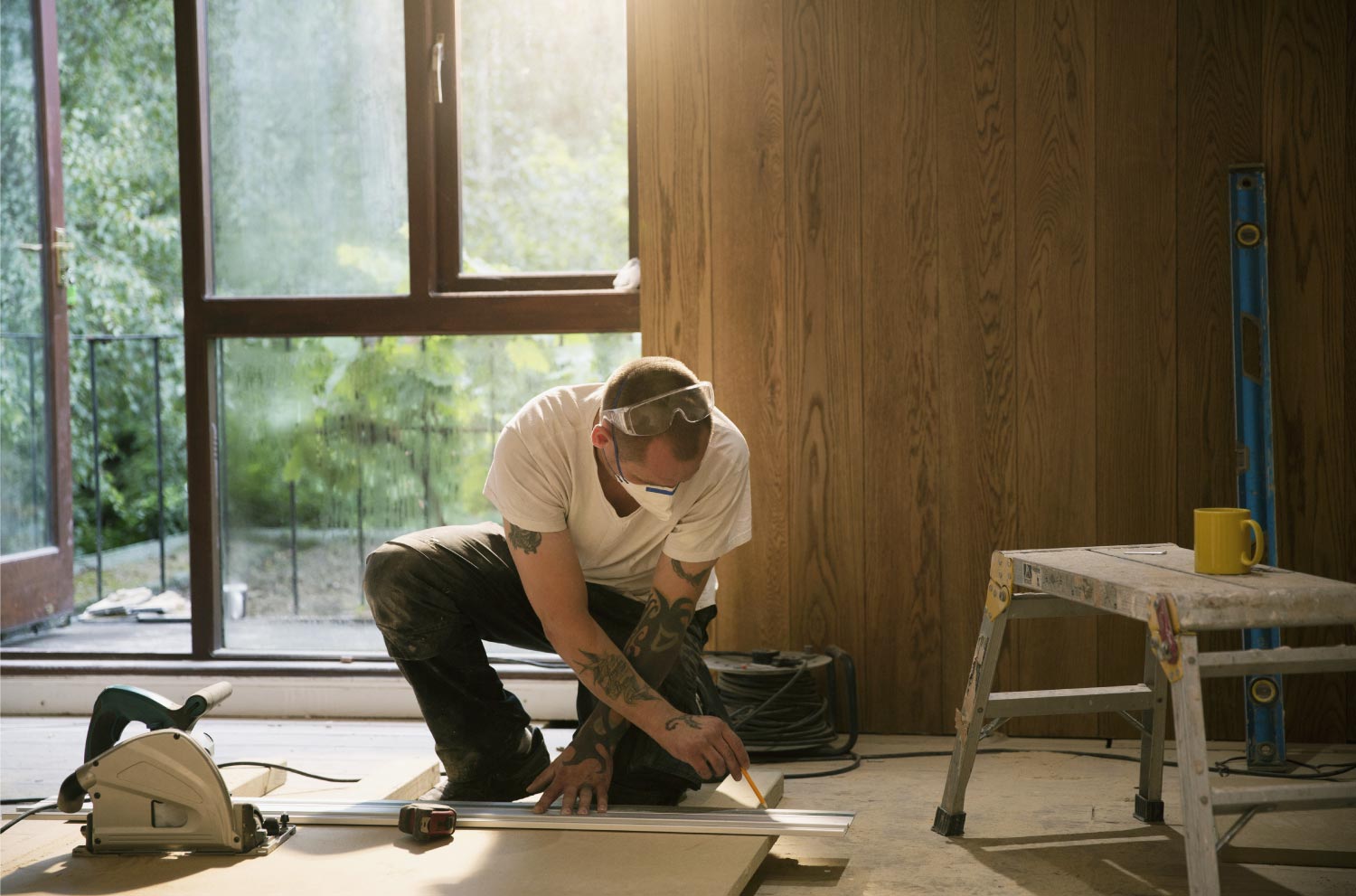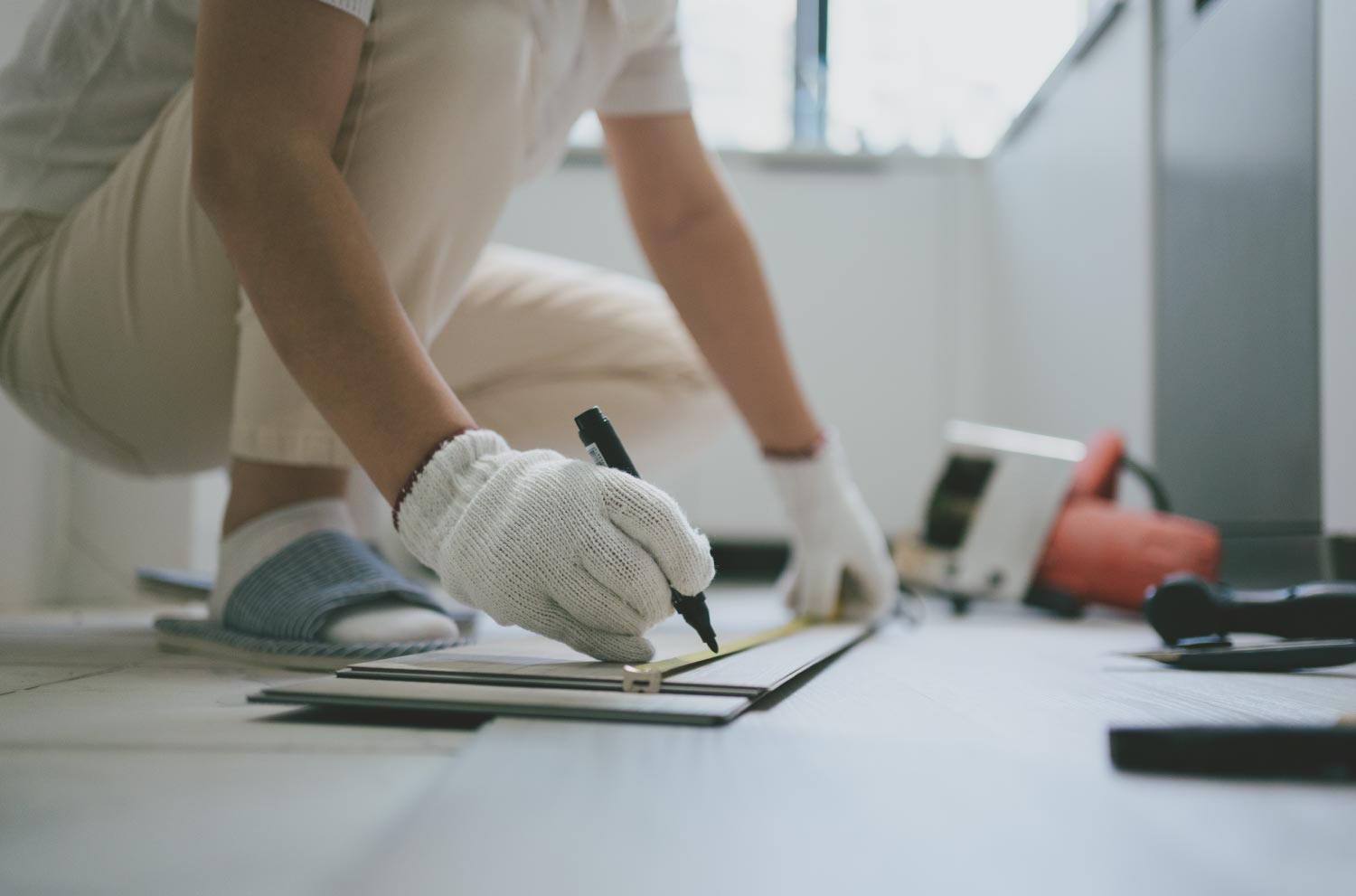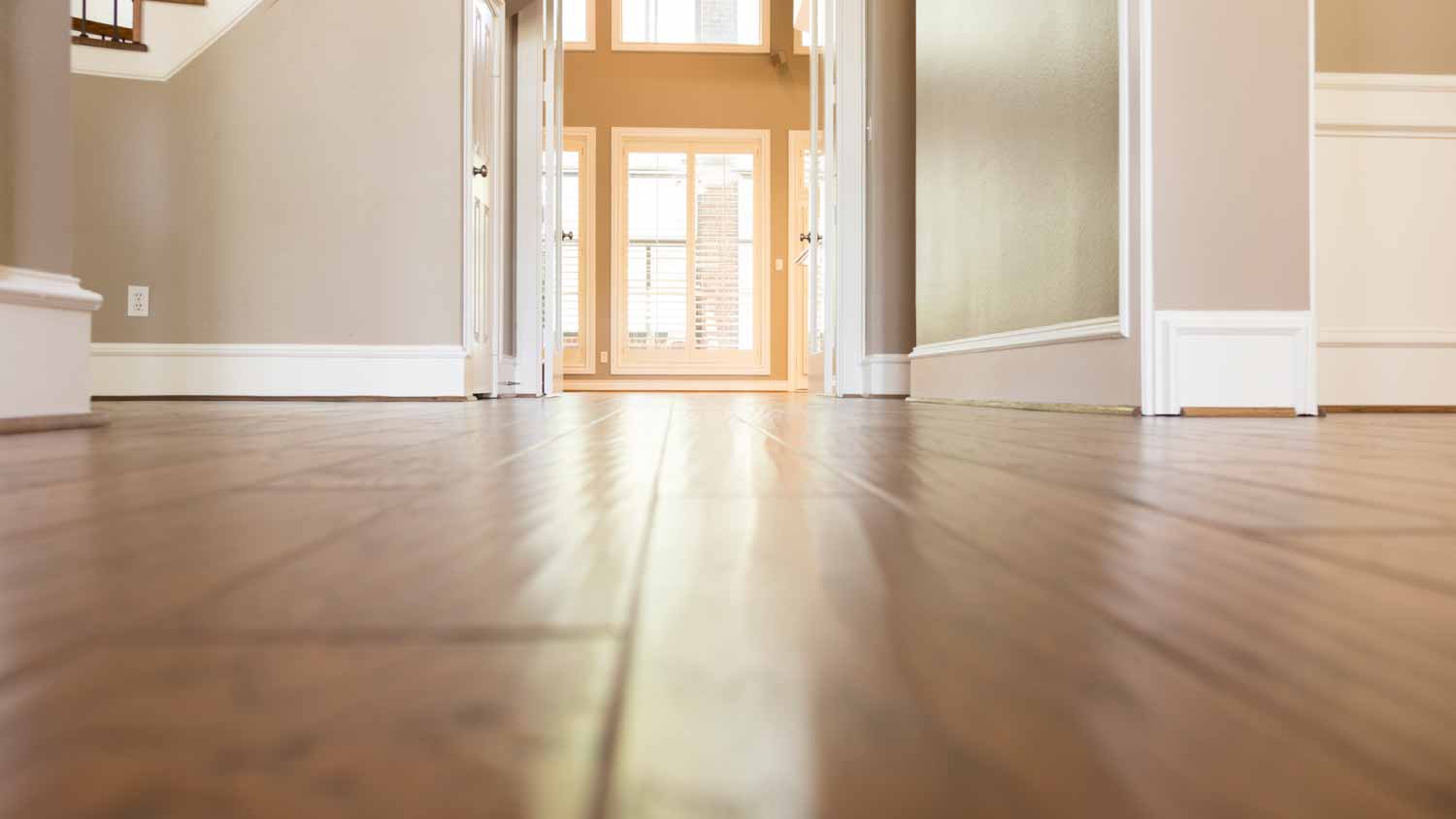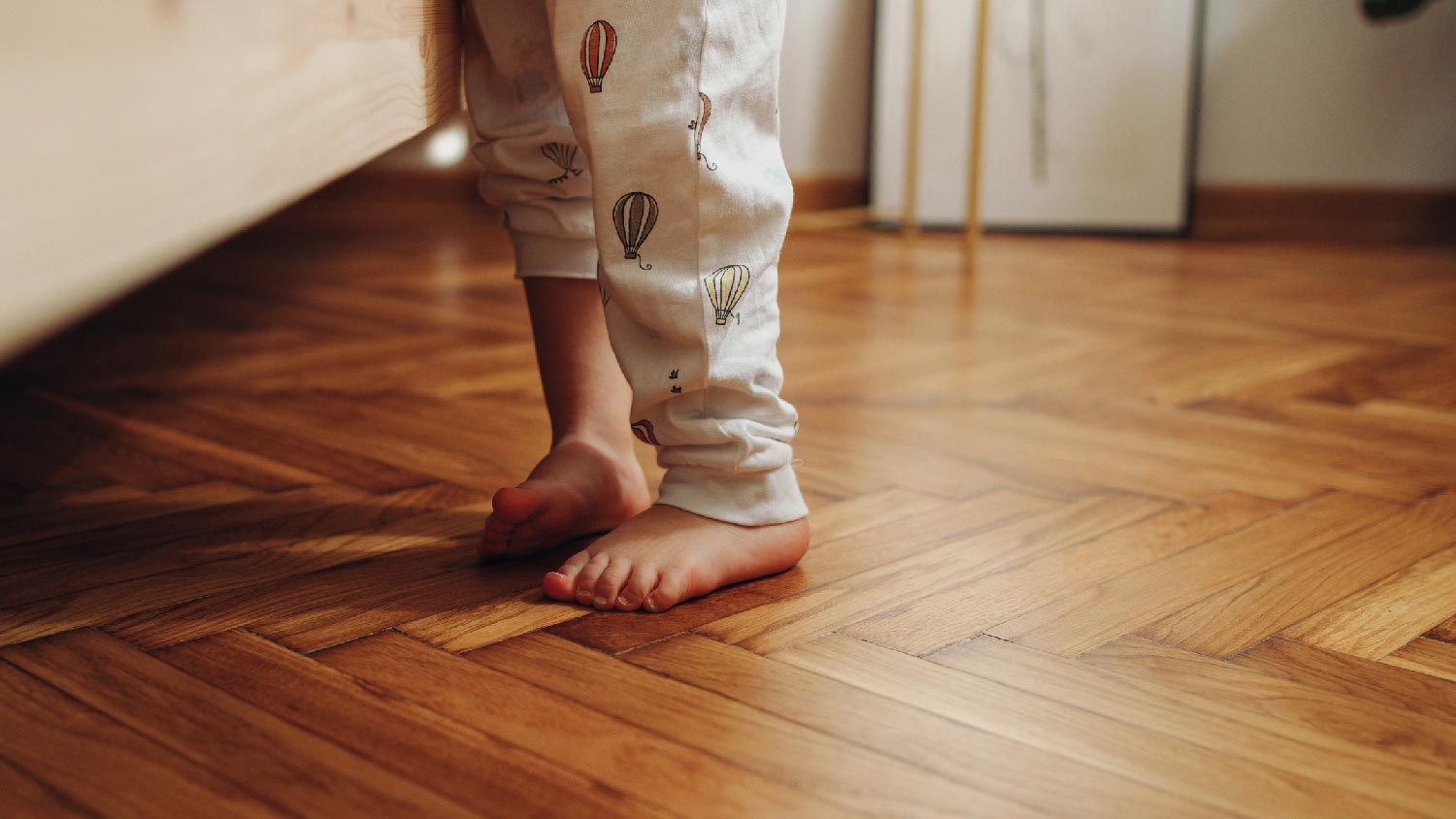How to Replace Damaged Hardwood Floor Planks Without Removing the Entire Floor
Sometimes a single-board swap is all your floor needs


- Circular saw
- Track saw (optional)
- Rubber mallet
- Crowbar
- Chisel
- New wood plank(s)
- Floor glue
Your beloved hardwood floor’s aesthetic can be easily upended by a rogue board with water damage, cracks, or grooves. But try not to fret—you can replace individual wood planks on your own without having to replace the entire floor. Learning how to replace hardwood floor planks requires you to understand your current hardwood flooring system, gather the right tools, and protect the rest of your undamaged boards. Let's jump in.
Identify the Problem
The process of learning how to repair hardwood floors begins with a diagnosis of what is going on. Without identifying the issue behind the wonky floorboard, the problem could keep coming back, even after the fix.
Some common problems with hardwood flooring include bowing and buckling, scratches, fading, and warping. Cosmetic issues caused by furniture or traffic gouges or scratches are clear candidates for replacement.
Warping and bowing, on the other hand, could be a sign of underlying issues like loose floor joists, a damaged subfloor, or even foundation issues. In these cases, it is best to contact a professional to take a look at the bigger picture.
Get to Know Your Floor Boards
If you are ready to take on the task of replacing hardwood floor boards, the most important step is properly measuring and identifying the ones in need of removal. The majority of boards, both old and new, have some sort of interlocking system—either a tongue-and-groove or a click-wood floor. Depending on its age, the floor may be held down using glue, fasteners, or nails.
When in doubt about the exact measurements or type of flooring, we recommend calling in a pro to help with this step of the process.
Floor Board Features
To choose the right replacement board for your floor, you will need to know:
The type of wood or laminate
The interlocking system used in other boards
The color or finish of your current boards
The depth of the board
What lies beneath the board (concrete, subflooring, etc.)
Cover Your Space
 Photo: Tom Merton / Caia Image / Adobe Stock
Photo: Tom Merton / Caia Image / Adobe StockBefore turning on any power tools, cover the rest of your floor with a protective layer of painter's plastic or paper. Dust will be an issue when sawing into the wood, so be sure to have proper ventilation or a ventilation feature on the saw itself.
Prepare Your Saw and Cutting Area
 Photo: THINK b / Adobe Stock
Photo: THINK b / Adobe StockGet your tape and mark the outside edges of the boards you are replacing.
Next, you need to set the depth of your circular saw. If you do not know the depth of the hardwood flooring, you may need to remove a transition strip to find out. Old flooring is usually ½ inch to one inch thick, but you won’t know for sure until you make a measurement.
Set your circular saw depth to the thickness of your board to avoid accidentally cutting into the underlayment or subfloor.
Make the First Cuts to Remove the Old Floor Board
Now it is time to start making the first cuts into the first board you want to remove. To do this, make a cut ½ inch inside the length of the board. Do the same for the other side of the board. Then, make a perpendicular cut to join the two cut lines. In the end, your cuts will look like an “H”. Put your circular saw away, and use your oscillating multi-tool to go over the same cuts one more time.
Remove the Old Board With a Flat or Pry Bar
To remove the old board, start by inserting a flathead screwdriver into the center cut. Hit the screwdriver with a rubber mallet until the opening is large enough to fit a pry bar. Next, wiggle the pry bar and remove all the pieces of the old board.
Once you are done with this step, use a vacuum to clean up any loose debris and dirt. Tape up your underlayment if you accidentally made cuts into it.
Prepare the New Floor Board
Before you install new hardwood flooring, allow it to acclimate to your home for at least 48 hours before installing.
To prepare the new floor board, take exact measurements of the hole in the floor. Then cut the length of the board on the groove side and trim the tongue side at a seven-degree angle. Cut the new board to the exact length with a miter saw.
Dry-Fit the New Board
Tap the fresh board into the empty space with your rubber mallet before adding glue or nails. If it is not the right fit, now is the time to adjust the edges by sanding or reshaping.
Glue and Secure
Remove the board and add one line of glue along each edge and through the center in a crisscross pattern. Place the new board into the slot and secure it lightly with the wooden mallet. If your board includes nails, add these now with a nail gun. You can cover these spots with wood putty later on to match the finish.
Let It Dry
Avoid walking on your new boards for at least 12 to 20 hours after gluing to ensure they do not shift. Once the glue dries and nail holes are nicely covered, your like-new flooring will be good to go.
DIY vs. Hiring a Pro to Replace Hardwood Floor Planks
While the cost of tools will range based on what you already have in your toolkit, you could save between $400 and $1,400 by repairing the floor yourself. On the other hand, if you are new to using a power saw or have a historic home, call in your local floor repair team for an expert eye.
Whether you want to DIY or call in a pro will depend on your experience level and if you have time to do the job. A poorly repaired floor may require further repair later down the road, so if you are at all unsure, save yourself time and money by hiring a pro.
Frequently Asked Questions
Yes, it is possible to replace just one plank in a hardwood floor. You may feel relieved to hear this, since hardwood floor costs are higher compared to other flooring types. You might have to do this if you have deep scratches on one board from moving furniture, or if you dropped something heavy and it left an unsightly dent. Other times, you may have cracked boards or buckling issues due to poor installation or moisture issues.
Yes, you can replace tongue-and-groove boards. The steps described above require you to remove the old boards you do not want, and then install new boards in their place. It is a straightforward process, but it can be a little tricky for DIYers that do not have flooring or woodworking experience. But if you can get it done properly, no one will be able to tell you that you repaired the floor.
In most cases, you will be able to match existing hardwood floors, although it depends on a few things. You should look for new boards with the same thickness and width as your existing floors, as well as the same species and grade of wood. Of course, you will also want to look for wood in a similar color, although you may need to refinish or stain the new piece for a better fit.
If you are ready to work on replacing floorboards but discover that your hardwood floor type has been discontinued, there are some options. You can get a piece of unfinished wood in the same wood type and thickness and stain it yourself. Also, consider contacting the manufacturer to see what similar products they may have in their product line that may work for you. Otherwise, you can contact a speciality company to customize exactly what you need.





















